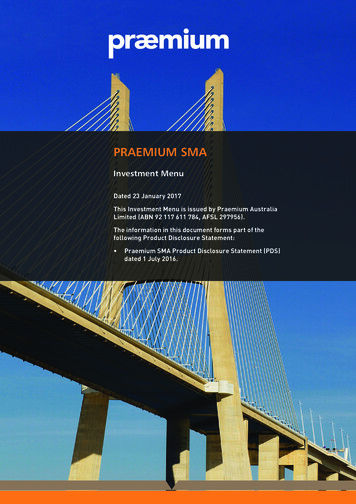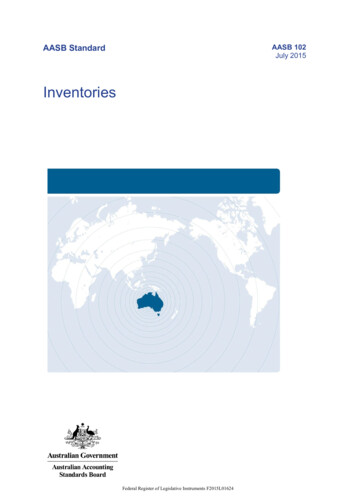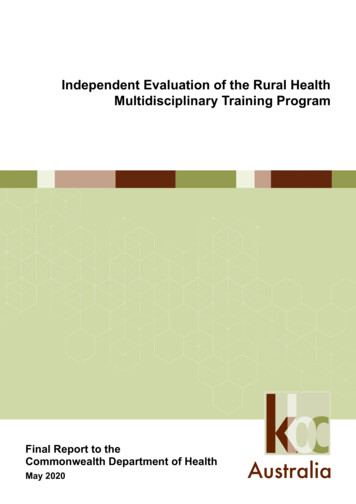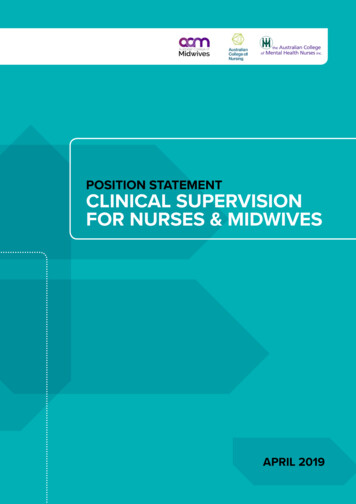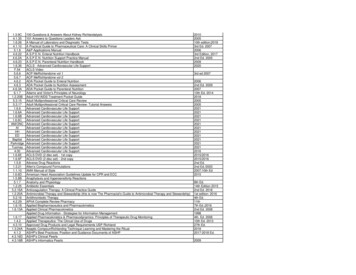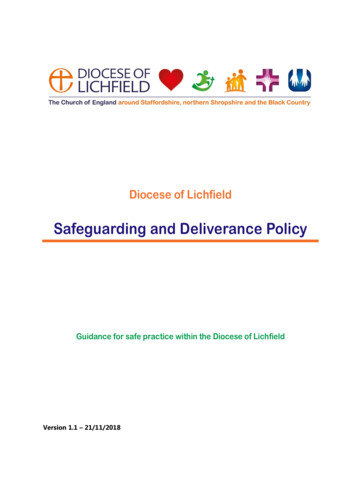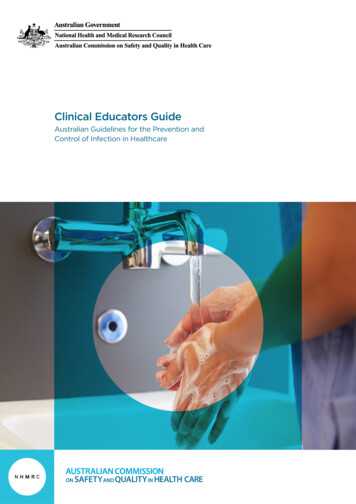
Transcription
Clinical EducatorsGuideAustralianGuidelinesfor the PreventionAustralianGuidelinesthe PreventionandControlofforInfectionin andHealthcareControl of Infection in Healthcare
The Clinical Educators Guide has been adapted based on the Australian Guidelines for the Prevention and Controlof Infection in Healthcare (2019) (the Guidelines). For further information and specific references please refer tothe Guideline.Publication DetailsPublication title: Clinical Educators Guide: Australian Guidelines for the Prevention and Controlof Infection in HealthcarePublished:December 2019Publisher:National Health and Medical Research CouncilNHMRC Publication reference:CD34AOnline version: 2019ISBN Online:978-1-86496-049-5Suggested citation: Clinical Educators Guide: Australian Guidelines for the Prevention and Controlof Infection in Healthcare, National Health and Medical Research Council (2019)Copyright Australian Government 2019All material presented in this publication is providedunder a Creative Commons Attribution 4.0 Internationallicence (www.creativecommons.org.au), with theexception of the Commonwealth Coat of Arms,NHMRC logo and any content identified as being ownedby third parties. The details of the relevant licenceconditions are available on the Creative Commonswebsite (www.creativecommons.org.au), as is the fulllegal code for the CC BY 4.0 International licence.AttributionCreative Commons Attribution 4.0 International Licenceis a standard form licence agreement that allows youto copy, distribute, transmit and adapt this publicationprovided that you attribute the work. The NHMRC’spreference is that you attribute this publication (and anymaterial sourced from it) using the following wording:Source: National Health and Medical Research Council.Use of imagesUnless otherwise stated, all images (including backgroundimages, icons and illustrations) are copyrighted by theiroriginal owners.Contact usTo obtain information regarding NHMRC publications or submit a copyright request, contact:E: nhmrc.publications@nhmrc.gov.auP: (02) 6217 9000
ContentsIntroduction 1Australian Guidelines for the Prevention and Control of Infection in Healthcare Healthcare-associated infection in Australia 22Healthcare-associated infection is preventable 2Infection prevention and control is everyone’s business 3Transmission of infection in healthcare 3Routes of transmission 4Contact transmission 4Droplet transmission 5Airborne transmission 5Standard and transmission-based precautions 6Standard Precautions 6Transmission-based precautions 6Overview of risk management in infection prevention and control 7Risk identification in the clinical context Organisational support 911Summary of Recommendations 16Glossary 23Clinical Educators Guide:Australian Guidelines for the Prevention and Control of Infection in Healthcareiii
IntroductionThis Guide has been developed to provide strategies for clinical educators and supervisorsto assist healthcare workers integrate a risk management approach into their daily tasks andduties that involve infection control.This Guide should be used in conjunction with the Australian Guidelines for the Prevention andControl of Infection in Healthcare (2019) and its key recommendations, practice statementsand statutory requirements, as well as the healthcare facility’s infection control program.All advice provided within the Guidelines has an accompanying title that is underpinned byvarying levels of scientific evidence used to support it. The Grading of RecommendationsAssessment, Development and Evaluation (GRADE) approach provides the evidence todecision framework, which determines the structure, title and final wording of each piece ofadvice as follows: Strong Recommendation: confident that the desirable effects of adherence to arecommendation outweigh the undesirable effects. Overall the recommendation is basedon high quality evidence and is strongly recommended for implementation. Weak/Conditional Recommendation: concludes that the desirable effects of adherence to arecommendation probably outweigh the undesirable effects. Overall, the recommendationis based on supportive evidence and a strong theoretical rationale and is recommendedfor implementation. Practice Statement: set for areas which are not covered by a systematic review ofthe evidence, but where the provision of clinical guidance is deemed important.The development of practice statements is primarily based on best practice as advised byexpert consensus and aligned with the GRADE approach where available evidence andjudgements are considered together however, a strength is not assigned. Statutory Requirement: this advice reflects a practice statement or recommendation.The terminology ‘statutory requirement’ is used to further indicate where there is also amandated requirement/s by the Commonwealth or the States/Territories, which must beconsidered when implementing the advice at the local level. It is important to note thatstatutory requirements vary across states and territories, and in their applicability to healthservice delivery sectors and settings.This Guide aims to ensure healthcare workers: are aware of the issue of healthcare-associated infections (HAI) in Australia understand the chain of infection know the different modes of transmission of infection in healthcare are aware of standard and transmission-based precautions and the role of these in theprevention of transmission of infection have a basic understanding of a risk management approach to infection preventionand control are able to identify potential risk for transmission of infection in the delivery of healthcareand decide what measures they should implement.Clinical Educators Guide:Australian Guidelines for the Prevention and Control of Infection in Healthcare1
Australian Guidelines for the Preventionand Control of Infection in HealthcareThe Guidelines provide a nationally accepted approach to infection prevention and control,focusing on core principles and priority areas for action. They provide a basis for healthcareworkers and healthcare facilities to develop detailed protocols and processes for infectionprevention and control specific to local settings.This approach is underpinned by a risk-management framework to ensure the basic principlesof infection prevention and control can be applied to a wide range of healthcare facilitiesincluding hospitals, day procedure units, office-based practice, long-term care facilities,remote area health services, home and community nursing and emergency services. It isrecognised that the level of risk may differ according to the different types of facility andtherefore some recommendations should be justified by risk assessment. When implementingthese recommendations all healthcare facilities need to consider the risk of transmission ofinfection and implement according to their specific setting and circumstances.The evidence base for the Guidelines addresses the highest level of risk of infection transmissionin the healthcare setting, and has predominantly been drawn from the acute-care setting.The recommendations should be read in the context of the evidence base and the advice on thepractical application of the recommendations.Healthcare-associatedinfection in AustraliaEffective infection prevention and control is central in providing high quality healthcare forpatients and a safe working environment for those that work in healthcare settings.Healthcare-associated infection ispreventableHAIs are infections acquired as a direct or indirect result of healthcare. In Australian acutehealthcare facilities, there are around 165,000 HAIs each year1. This makes HAIs the mostcommon complication affecting patients in hospital. HAIs can occur in any healthcare setting,including office-based practices (e.g. general practice clinics, dental clinics, community healthfacilities), the settings in which paramedics work and long-term care facilities.These infections are caused by infectious agents such as bacteria and viruses. They arepotentially preventable adverse events rather than unpredictable complications. Any personworking in or entering a healthcare facility is at risk of transmitting infection or being infected.Effective infection prevention and control strategies can significantly reduce the incidenceof HAI.1 Mitchell BG, Shaban RZ, MacBeth D, Wood C-J, Russo PL : The burden of healthcare-associated infection in Australianhospitals: A systematic review of the literature. Infection, Disease & Health 2017;Clinical Educators Guide:Australian Guidelines for the Prevention and Control of Infection in Healthcare2
Infection prevention and control iseveryone’s businessUnderstanding the modes of transmission of infectious agents and knowing how and whento apply the basic principles of infection prevention and control is critical to the success of aninfection control program. This responsibility applies to everybody working in and visiting ahealthcare facility, including administrators, staff, patients and carers.Transmission of infection in healthcareInfectious agents can exist in the natural and built environment, as well as in and on thebody. Not all microorganisms are infectious agents, as some do not cause infection,(e.g. ‘good’ bacteria present in the body’s normal flora). Parasites, prions and several classesof microorganism—including bacteria, viruses, fungi and protozoa—can be involved in eithercolonisation or infection, depending on the susceptibility of the host: With colonisation, there is a sustained presence of replicating infectious agents on or in thebody, without causing infection or disease With infection, invasion of infectious agents into the body results in an immune response,with or without symptomatic disease.Transmission of infectious agents within a healthcare setting requires all of the followingelements: causative agent (pathogen) reservoir portal of exit means of transmission portal of entry a susceptible host.Clinical Educators Guide:Australian Guidelines for the Prevention and Control of Infection in Healthcare3
This is called the chain of infection (Figure 1). Interruption of this cycle is a strategy to limit thespread of ain ofinfectiontransmissionPortal ofEntryPortal of ExitMeans ofTransmissionFigure 1. Chain of Infection TransmissionRoutes of transmissionIn healthcare settings, infectious agents can be transmitted via: contact droplet airborne modes.Contact transmissionContact is the most common mode of transmission, and usually involves transmission by touchor via contact with blood or body substances. Contact may be direct or indirect. Direct transmission occurs when infectious agents are transferred from one person toanother. This can occur via physical contact (hands touching), injections or ingestion.For example, a patient’s blood entering a healthcare worker’s body through an unprotectedcut in the skin. Indirect transmission involves the transfer of an infectious agent through a contaminatedintermediate object (equipment or environment) or person—for example, a healthcareworker’s hands transmitting infectious agents after touching an infected body site on onepatient and not performing proper hand hygiene before touching another patient, or ahealthcare worker coming into contact with fomites (e.g. bedding) or faeces and thentouching a patient without performing hand hygiene.Clinical Educators Guide:Australian Guidelines for the Prevention and Control of Infection in Healthcare4
Droplet transmissionDroplet transmission can occur when an infected person coughs, sneezes or talks, andduring certain procedures. Droplets are infectious particles larger than 5 microns in size.Respiratory droplets transmit infection when they travel directly from the respiratory tract ofthe infected person to susceptible mucosal surfaces (nasal, conjunctival or oral) of anotherperson, generally over short distances. Droplet distribution is limited by the force of expulsionand gravity and is usually no more than 1 metre.Airborne transmissionAirborne transmission may occur via particles containing infectious agents that remaininfective over time and distance. Small-particle aerosols (often smaller than 5 microns) arecreated during breathing, talking, coughing or sneezing and secondarily by evaporation oflarger droplets in conditions of low humidity. Aerosols containing infectious agents can bedispersed over long distances by air currents (e.g. ventilation or air conditioning systems) andinhaled by susceptible individuals who have not had any contact with the infectious person.These small particles suspended in the air are referred to as droplet nuclei and can transmitinfection into small airways of the respiratory tract.Figure 2 illustrates the different routes of transmission and their more specific ectHandsAirborneDroplet nuclei(Suspended in air)Equipment/environmentInjectionIngestionFigure 2. Transmission of infectious agentsClinical Educators Guide:Australian Guidelines for the Prevention and Control of Infection in Healthcare5
Standard and transmission-basedprecautionsStandard precautionsStandard precautions refer to those work practices that are applied during all instances ofpatient care, regardless of a perceived or confirmed infectious status. Implementing standardprecautions as a first-line approach to infection prevention and control in healthcare facilitiesminimises the risk of transmission of infectious agents from person to person, even inhigh‑risk situations.How standard precautions are implemented: hand hygiene, as consistent with the 5 Moments for Hand Hygiene the use of appropriate personal protective equipment (PPE) the safe use and disposal of sharps routine environmental cleaning reprocessing of reusable medical equipment and instruments respiratory hygiene and cough etiquette aseptic technique waste management appropriate handling of linen.Transmission-based precautionsAny infection prevention and control strategy should be based on the use of standardprecautions as a minimum level of control. Transmission-based precautions are recommendedas additional work practices in situations where standard precautions alone may beinsufficient to prevent transmission.Transmission-based precautions should be tailored to the particular infectious agent involvedand its mode of transmission. This may involve a combination of practices.Types of transmission-based precautions: Contact precautions are used when there is known or suspected risk of direct orindirect contact transmission of infectious agents that are not effectively contained bystandard precautions alone. Droplet precautions are used for patients known or suspected to be infected withagents transmitted over short distances by large respiratory droplets. Airborne precautions are used for patients known or suspected to be infected withagents transmitted person-to-person by the airborne route.Strategies for implementing transmission-based precautions: continued implementation of standard precautions dynamic risk assessment in the pre-admission setting to anticipate and communicatethe potential need for transmission-based precautions on patient arrivalClinical Educators Guide:Australian Guidelines for the Prevention and Control of Infection in Healthcare6
if patient has a suspected or confirmed infection, allocate a single room inclusive ofbathroom facilities and a door that can be closed (isolation) if the above strategy is not possible then place patients colonised or infected with thesame infectious agent in a room together (cohorting) wearing specific personal protective equipment providing patient-dedicated equipment using sodium hypochlorite, or an appropriate Therapeutic Goods Administration-listedhospital-grade disinfectant (with specific claims), daily on frequently touched surfacesand on general surfaces when visibly soiled or immediately after a spillage using specific air handling techniques restricting the movement of both patients and healthcare workers.Overview of riskmanagement in infectionprevention and controlIn the context of infection prevention and control in healthcare facilities, ‘risk’ is defined as thepossibility of microorganism colonisation or infection in patients or healthcare workers arisingfrom activities within a healthcare facility.Risk management is the basis for preventing and reducing harms arising from HAI.Infection control is a health and safety issue, which means that all those working in thehealthcare facility — managers, healthcare workers and support staff — are responsible forproviding a safe environment for patients and other staff.A successful approach to risk management occurs on many levels within a healthcare facility: Facility wide—for example, providing support for effective risk management through anorganisational risk-management policy, staff training, follow-up of outcomes, monitoring,reporting and enabling access to information systems that can be used to informrisk assessment. Ward or department based—for example, embedding risk management into all policies sothat risks are considered in every situation. Individual—for example, considering the risks involved in carrying out a specific procedureand questioning the necessity of the procedure as part of clinical decision-making,attending education sessions (e.g. hand hygiene or respirator fit testing).As healthcare facilities differ greatly in their day-to-day function, it is not possible to providea one size fits all approach to risk management. Even within a single setting (e.g. primarycare), increasingly complex care is delivered by a range of health professionals with diversequalifications and training. All healthcare facilities need to be able to determine the risks intheir own context and select the appropriate course of action. It is necessary for facilities toregularly conduct infection prevention risk assessments within their facility and ensure that allstaff understand their responsibility in managing these risks. In addition, healthcare facilitiesshould develop detailed protocols and processes for infection prevention and control specificto local settings.Clinical Educators Guide:Australian Guidelines for the Prevention and Control of Infection in Healthcare7
In most cases it is not necessary to undertake a complete risk assessment when performingroutine tasks, but it is essential for healthcare workers to be able to identify and analyse thepotential risks of transmission.Figure 3 below shows a risk management approach in the context of the chain ofinfection to ensure exposure to sources of infection is minimised for both the patient andhealthcare worker.Establish the contextAvoid risksIdentify risksCommunicateand consultMonitor andreviewAnalyse risksEvaluate risksTreat risksFigure 3. The risk management flowchartClinical Educators Guide:Australian Guidelines for the Prevention and Control of Infection in Healthcare8
Risk identification in theclinical contextThe following section demonstrates the decision-making steps behind identification,assessment and treatment of potential risks of transmission of infection during the delivery ofcare. Tables 1 and 2 provide clinical examples to illustrate this approach. This is based on thecontent in the 2019 Australian Guidelines for Prevention and Control of Infection in Healthcare.1. Establish the contextIdentify the basic parameters in which risk must be managed e.g. type of health facility,extent of and support for the facility’s infection prevention and control program.2. Avoid risksThe best way to manage a risk is to avoid it. It is valuable to consider the following beforeperforming a procedure: Is the planned task/intervention necessary? Are there alternative procedures that could eliminate or minimise any potentialexposure of the patient or yourself and others to infectious agents? For example:– Is it necessary to change the dressing today?– Does the patient still require an intravascular device, or can it be removed?3. Identify risksWhen approaching a clinical task or duty it is useful to consider the risks of HAI transmissionin terms of when/where/why and how they can occur. For example:What potential agents are involved? i.e. the source How are they transmitted? i.e. mode of transmission direct and indirect Who is at risk of infection? i.e. patient, healthcare worker or the patient care area?Table 2 provides prompts to assist in identifying the risks for HAI transmission and forconsidering what controls can be taken to interrupt the chain of infection.4. Analyse riskThe identified risks associated with the task/duty need to be analysed. This can be achievedby considering: How can transmission happen? i.e. what are the aspects of the duty/procedure thatcan transmit infection? What existing controls are in place to minimise the risk? i.e. are there sets ofprocedures or protocols in place that minimise the risk of transmission? What is the likelihood of transmission? What is the likelihood of associated morbidity or mortality associated with HAI? What is the likelihood of increased length of hospitalisation? What factors increase or decrease the risk?Clinical Educators Guide:Australian Guidelines for the Prevention and Control of Infection in Healthcare9
5. Evaluate riskThe next stage requires assessment of whether the level of risk is acceptable or not.Factors that influence this decision are: Is the risk so low that it is not considered a problem?– i.e. taking the blood pressure of a healthy individual is considered to have a low riskof transmission of infection Does the need to perform the task/duties outweigh the possible risk of HAItransmission?– e.g. delaying transfer to radiology due to infection may lead to further patientdeterioration What can be done to reduce or eliminate the risk?– e.g. develop a prioritised list of actions to break the chain of infection Can extra steps be taken to minimise or mitigate the risk?– e.g. using an aseptic technique to dress a wound or wearing gloves and gownswhen contacting a patient suspected to have MRSA Would this risk be acceptable/not acceptable in a different clinical setting?– i.e. are there special considerations required given the clinical environment,such as ICU versus outpatients, that will affect the actions taken to break the chainof infection?6. Treat the riskAt this step, all the information gathered from the analysis and evaluation on the risk ofHAI transmission is brought together to consider what actions should be taken. In orderto make this decision, consider how the level of risk will be affected by the proposedmitigation strategies.The choice in the course of action can include: Avoiding the risk: choosing an alternate lower risk procedure or task. Reducing the risk: can the likelihood be reduced through preventative measures, andexisting systems and controls i.e. are there policies and procedures in place to guide thebest way to perform the required task and minimise the risk? Transferring the risk: getting another individual or team to assist/perform the task who arebetter equipped or have more experience in undertaking the task. Retaining the risk and managing it: strategies include using PPE (see Table 1) and safetyengineered devices.The following questions assist in deciding what strategy should be adopted: What can be done to address the risk? i.e. from my analysis and evaluation will thetreatment of the risk lower the level of risk sufficiently? Who is responsible? e.g. some aspects of the risk mitigation strategy will involve othermembers of the HCF teamClinical Educators Guide:Australian Guidelines for the Prevention and Control of Infection in Healthcare10
Monitoring and review is an essential component of the risk-management process.This ensures that: new risks are identified analysis of risk is verified against real data, if possible risk treatment is implemented effectively.Thinking exerciseHow would you put into practice the following scenarios to minimise the risk of infection?Scenario 1: a child with chickenpox in an antenatal clinic waiting roomScenario 2: a patient with MRSA sharing a room with three patients without MRSAIn each scenario, consider: who is at risk what is the risk why is it a risk what steps are needed to treat the risk.Organisational supportFor infection prevention and control to be effective at the clinical level, much organisationalsupport is required. This includes embedding infection control into governance andmanagement structures, initiating procedures (e.g. immunisation programs) to ensure thathealthcare workers are protected, instituting processes for surveillance that feed into theoverall quality control program, implementing systems for ongoing staff education andtraining, and incorporating infection control into planning for facility design and maintenance.Organisational support should aim to ensure that clinical work practices provide patientcentred care—this is not only essential from a safety and quality perspective, but out ofconsideration for patient preferences. This may require consultation with patients and relevantconsumer groups in the development of healthcare services.Table 1: Summary of Personal Protective Equipment maskEyeprotectionGown -----Routineobservations (e.g.blood pressuremeasurement) -----General medicalexamination - If splashrisk likelyIf splashrisk likelyIf splashrisk likelyProcedureActivities of dailyliving(e.g. washing,toilet)For contactwith brokenskin/ rash/mucousmembraneClinical Educators Guide:Australian Guidelines for the Prevention and Control of Infection in Healthcare11
ctionGownWoundexamination/dressing For contactwith bodysubstancesFor directcontactwith woundFor woundFor woundFor grosslyirrigation if irrigation if infectedsplash likely splash likely woundsBlood glucoseand haemoglobinmonitoring ----Vaginal delivery - - Intravenouscannula insertion -- -Intravascularaccess deviceinsertion Intravascularaccess device care - - -Surgical aseptictechniqueprocedure e.g.lumbar puncture - Insertion of urinarycatheter - If exposurerisk likelyIf exposurerisk likelyIf exposurerisk likelyUrinary cathetercare - WhenemptyingdrainagebagIf exposurerisk likelySuctioning:endotracheal tube,tracheostomy Major dentalprocedures - Routine intra-oraldental procedures - ProcedureIf splashrisk likely- Where max.barrierprecautionsare used -- Dominanthand (opensuctionsystem)If exposurerisk likelyIf exposurerisk likelyClinical Educators Guide:Australian Guidelines for the Prevention and Control of Infection in Healthcare12
Table 2: Decision Making on Risk ManagementClinical TasksIdentify the RiskTreat the RiskDoes theactivityinvolve Who is atrisk?What is theHow is itpotential source transmitted?of the infectiousagent?What can I do to break thechain of infection?(see also Table 1)Directphysicalcontact with:PatientContaminated Standard precautionsHealthcareworkerHealthcareworkers’ handsPatient careareaDirectphysicalcontact with:Broken skin ’ handsMedicaldevices/Patient careequipmentareaBlood or bodysubstancesPatientHealthcareworkers’ handsPoor techniqueContaminatedequipmentDirect andindirectcontacttransmissionContact Clean surfaces withappropriate solution beforeand after useEvaluation of Risk – is the level of risk acceptable? What else can be done?Medicaldevices/equipment Perform hand hygieneAnalysis of Risk – determine the level of risk, i.e. the likelihood and consequence?Intact skinDirect andindirectcontacttransmission Standard precautions Perform hand hygiene Appropriate use of PPE e.g.gloves, gown , eye protection Clean surfaces withappropriate solution beforeand after use Aseptic technique Standard precautions Perform hand hygiene Appropriate use of PPE e.g.gloves, gown , eye protection Clean surfaces withappropriate solution beforeand after use Aseptic technique Employ correct technique Single use equipment Has the device beappropriately reprocessed? Note: Instruments used oncritical sites are requiredto be sterile. Semi-criticalinstruments require high-leveldisinfection.Clinical Educators Guide:Australian Guidelines for the Prevention and Control of Infection in Healthcare13
Clinical TasksIdentify the RiskTreat the RiskDoes theactivityinvolve Who is atrisk?What can I do to break thechain of infection?(see also Table 1)Handling ofsharp rkerBodythroughsubstancesneedle stickinjuryWhat is theHow is itpotential source transmitted?of the infectiousagent?Contact Standard precautions Correct use and disposal ofsingle use sharps at point ofcare where possible Correct transport of reusablesharps Correct techniqueand trainingMucosalsecretions,includingPatient caredroplets fromareacoughs andsneezesAerosolscreated by theproceduresPhysicalcontact withclinical wastee.g. dressingsHealthcareworkerPhysicalcontactwith humanwaste orcontaminatedlaundry,clothing, orequipmente.g. handlingof soiledlinen, orassisting withtoiletingHealthcareworkerBlood and bodysubstancesAirborne(such as TBand measles)Droplet (suchas influenza)Indirectcontact viacontaminationof patientcare area bydropletsContactPatient careareaPatient careareaBlood and bodysubstancesContact Airborne precautions requirethe use of a P2 respirator Droplet precautions requirethe use of a surgical maskEvaluation of Risk – is the level of risk acceptable? What else can be done?HealthcareworkerAnalysis of Risk – determine the level of
legal code for the CC BY 4.0 International licence. Attribution Creative Commons Attribution 4.0 International Licence is a standard form licence agreement that allows you to copy, distribute, transmit and adapt this publication provided that you attribute the work. The NHMRC's preference is that you attribute this publication (and any
